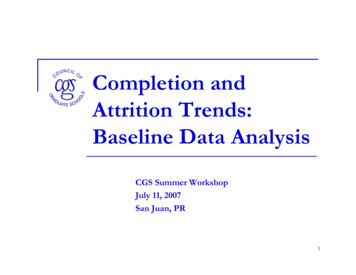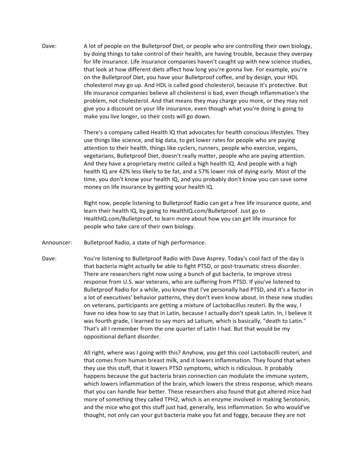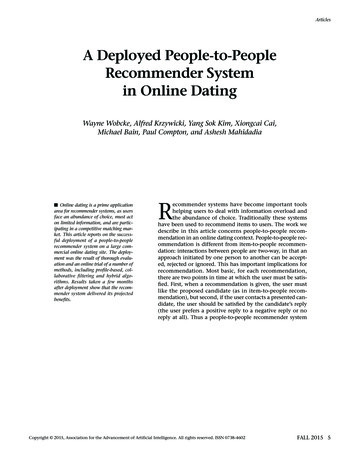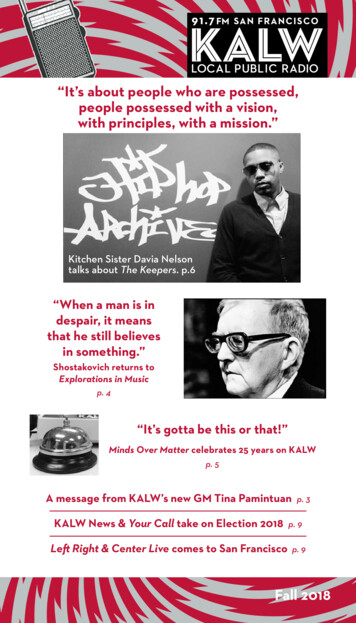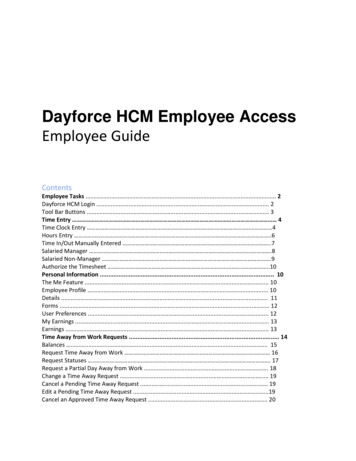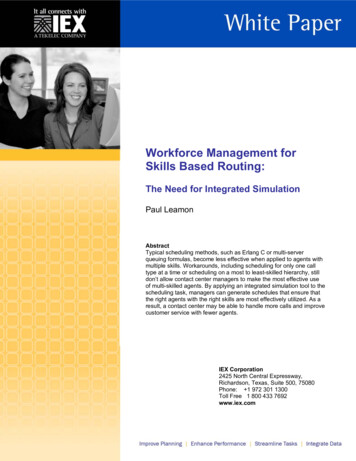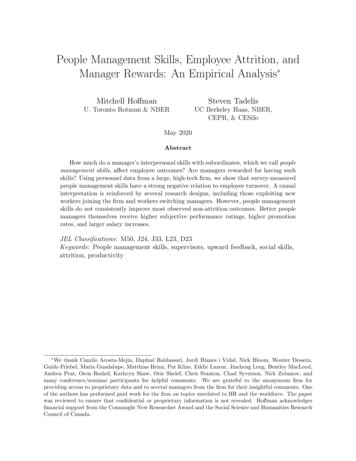
Transcription
People Management Skills, Employee Attrition, andManager Rewards: An Empirical AnalysisMitchell Ho manSteven TadelisU. Toronto Rotman & NBERUC Berkeley Haas, NBER,CEPR, & CESifoMay 2020AbstractHow much do a manager’s interpersonal skills with subordinates, which we call peoplemanagement skills, a ect employee outcomes? Are managers rewarded for having suchskills? Using personnel data from a large, high-tech firm, we show that survey-measuredpeople management skills have a strong negative relation to employee turnover. A causalinterpretation is reinforced by several research designs, including those exploiting newworkers joining the firm and workers switching managers. However, people managementskills do not consistently improve most observed non-attrition outcomes. Better peoplemanagers themselves receive higher subjective performance ratings, higher promotionrates, and larger salary increases.JEL Classifications: M50, J24, J33, L23, D23Keywords: People management skills, supervisors, upward feedback, social skills,attrition, productivityWe thank Camilo Acosta-Mejia, Daphné Baldassari, Jordi Blanes i Vidal, Nick Bloom, Wouter Dessein,Guido Friebel, Maria Guadalupe, Matthias Heinz, Pat Kline, Eddie Lazear, Jincheng Leng, Bentley MacLeod,Andrea Prat, Oren Reshef, Kathryn Shaw, Orie Shelef, Chris Stanton, Chad Syverson, Nick Zubanov, andmany conference/seminar participants for helpful comments. We are grateful to the anonymous firm forproviding access to proprietary data and to several managers from the firm for their insightful comments. Oneof the authors has performed paid work for the firm on topics unrelated to HR and the workforce. The paperwas reviewed to ensure that confidential or proprietary information is not revealed. Ho man acknowledgesfinancial support from the Connaught New Researcher Award and the Social Science and Humanities ResearchCouncil of Canada.
1IntroductionIt is broadly accepted that even within narrow industries, there are large and persistent productivity di erences across firms and countries (Syverson, 2011). While a growing literatureshows that management practices a ect firm performance and help explain these productivitydi erences (Ichniowski et al., 1997; Ichniowski and Shaw, 1999; Bloom and Van Reenen, 2007;Bloom et al., 2013, 2019), less attention has been devoted to managers themselves.Of particular interest to understanding how managers a ect outcomes are people management skills, which we take to be a manager’s interpersonal (i.e., social) skills in relationswith their subordinates. Non-cognitive skills like social skills play a key role in economic life(Heckman and Kautz, 2012) and social skills are increasingly rewarded in the labor market(Deming, 2017). How much do good people management skills matter for employee outcomes?Are good people management skills rewarded inside the firm?We answer these questions using employee surveys conducted at a large, high-tech firmcombined with rich personnel data that cover thousands of managers and tens of thousandsof employees. We show that people management skills (1) reduce employee attrition, particularly attrition the firm wishes to avoid, and that the relation appears causal; (2) do notconsistently improve most non-attrition outcomes; and (3) are rewarded by the firm. We explore how the impact of people management skills varies across levels of hierarchy, countries,and occupations, providing granular quantification of managerial di erences within the samemultinational firm.Progress has been made in examining how much managers matter using a “value-added”(VA) approach. Bertrand and Schoar (2003) examine how much CEOs matter by regressingfirm outcomes on CEO fixed e ects, pioneering an approach used by a subsequent financeliterature. Lazear et al. (2015) use data from one firm to show that frontline supervisorsmatter a great deal for productivity. Bender et al. (2018) analyze interactions between employees/managers and management practices in Germany.Despite its strengths, the VA approach faces two main limitations when applied to ourresearch questions. First, VA estimates measure the overall impact of a given manager onindividual outcomes, not the separate impact of people management skills. A manager’straits may include the ability to bring in high-value clients, or better problem-solving skills.Second, VA studies require good objective data on worker productivity. However, in manyfirms, direct data on individual worker productivity is scarce, and sometimes impossible tomeasure, particularly in high-skill, collaborative environments.We take a di erent yet complementary approach to VA by measuring people management skills using employees’ responses to questions about their manager (e.g., whether their1
manager is trustworthy or provides adequate coaching).1 We explore the extent to whichpeople management skills relate to employee outcomes, with the greatest focus on employeeattrition. Conventional wisdom, especially in high-tech firms, is that employee attrition is akey way by which worker knowledge and skills are lost. As such, high-tech firms are deeplyinterested in what can be done to reduce turnover, particularly that of high performers.Our data are well-suited to address possible concerns about measuring people management skills using surveys. First, the response rate at our firm is about 95%. Second, whileemployees may fear their manager will know how they evaluated them, this concern is mitigated due to the confidential nature of the survey. Workers are truthfully told that theirindividual responses will never be observed by the firm. Instead, managers receive aggregatedresults, and only for managers with a minimum number of employees responding. Third,survey responses may contain measurement error due to inattentiveness, sampling error, ordi erent employees treating questions di erently. We address this using an instrumental variable (IV) strategy where a manager’s score in one wave is instrumented using his or her scorein the other wave. Section 2 further describes the data. Section 3 covers our empirical strategy.Our first main finding, presented in Section 4, is that people management skills havea strong negative relation to employee attrition. Increasing a manager’s people managementskills from the 10th to the 90th percentile predicts a 60% reduction in turnover. These resultsare quite strong in terms of retaining the firm’s high performers, both defined in terms ofclassifying employees based on subjective performance scores and using the firm’s definition of“regretted” voluntary turnover. Beyond classical measurement error, the IV strategy addressessurvey measurement error that is contemporaneously correlated with attrition.Still, the question remains whether these results are causal. Even for our IV estimates,there are concerns about non-contemporaneous measurement error in people managementskills that is correlated with employee attrition, as well as concerns that the firm optimallysorts managers and employees together. We address these using multiple identification strategies, some similar to those in the teacher VA literature (e.g., Chetty et al., 2014). Our firststrategy analyzes outcomes of employees who join mid-way through our sample, using a manager’s quality measured before an employee joins the firm as an IV. This addresses concernabout non-permanent, unobservable shocks a ecting turnover and manager ratings, and reduces concern that the results are driven by the firm sorting managers and employees basedon long-time information about the employee. Our second strategy additionally analyzesinstances of workers switching managers, allowing us to test for non-random assignment of1Many organizations survey employees about their managers, including Google (Garvin et al., 2013), RBC(Shaw and Schifrin, 2015), Pepsi (Bracken et al., 2016), and the U.S. federal government (Arrington andDwyer, 2018). CultureAmp, a firm survey vendor, informed us in 2018 that about 15-20% of its 1,000 clientsuse upward feedback surveys (i.e., surveys of employees about their managers) focused on giving managersfeedback.2
managers and workers, and to analyze how the impact of people management skills variesbased on time together between a manager and employee. Our third strategy exploits managers moving across locations or job functions within the firm, allowing us to address morepermanent unobservables as well as to rule out assignment bias. All strategies point to peoplemanagement skills having a strong, causal e ect on attrition. Section 5 discusses heterogeneityin MOR e ects.Section 6 shows that people management skills do not have a consistent positive relationto most observed non-attrition employee outcomes. We find no evidence of a positive relationbetween people management skills and employee salary growth, probability of promotion, orpatenting. There is some evidence of a positive relation for employee subjective performance,but results are not robust across analyses. These findings suggest that better people management skills do not reduce attrition by making workers more “productive” (though we freelyadmit that it is hard to measure knowledge worker productivity), but may instead cause workers to better enjoy their jobs. We caveat that most non-attrition outcomes are not observedin our data and that e ects could be observed over a longer horizon.Section 7 establishes our secondary result that managers with better people managementskills get rewarded by the firm. Better people managers attain substantially higher subjectiveperformance scores, are more likely to be promoted, and receive larger salary increases. Suchresults are consistent with the firm valuing the role of good people management skills inreducing employee turnover.Our paper contributes to several literatures. First, it relates to work on individualmanagers, from which Lazear et al. (2015), who study the impact of front-line supervisorsin a low-skill setting, is most related.2 Aside from focusing on a large high-tech firm, ourpaper di ers from theirs in several other ways. Most notably, their VA approach shows thatmanagers matter, but this may be through “hard” skills, like problem-solving, and soft skills,which is our focus. Also, unlike Lazear et al. (2015), we are able to test whether managersare rewarded for skills. Our paper also di ers by analyzing quasi-experiments from managersswitching locations or functions, and by characterizing heterogeneity in estimates by hierarchy,geography, and occupation. Beyond the broader VA literature, our paper relates to other workthat tries to open the black-box of what managers do. For example, Bandiera et al. (2020)use CEO diary data and find that CEOs who focus on high-level agendas outperform thosewho focus on functional management. We instead explore managerial di erences by usingemployee surveys as a measure of manager skills. Like prior work showing that managementpractices can be usefully measured using surveys (Ichniowski et al., 1997; Bloom and Van2Also, Bandiera et al. (2007) show that manager bonuses boost productivity. Bandiera et al. (2015) studymatching of top managers and firms. Friebel et al. (2018) show that store managers change behavior inresponse to letters.3
Reenen, 2007), we show the same is true of particular managerial skills.Second, it relates to studies of compensation in firms (e.g., Baker et al., 1994a), providingnovel evidence that people management skills are rewarded within the firm. We find thatpeople management skills are a much stronger predictor of rewards by the firm than attritionVA; hence, a researcher using attrition VA who lacked data on people management skillswould reach di erent conclusions than ours regarding manager rewards.Third, we contribute to the growing literature on social skills in the workplace. Peoplemanagement skills are one variety of “social” or “people” skills. Social skills are generallyconsidered to be a person’s ability to communicate e ectively with others (Borghans et al.,2014), and we define people management skills as a manager’s ability to e ectively interactwith their subordinates. Deming (2017) emphasizes that social skills are important for teamwork (horizontal production). We provide novel evidence that social skills are also importantin management (vertical production). Relatedly, Schoar (2016) shows that an interventionin garment factories aimed at improving supervisors’ communication skills and treatment ofworkers improved productivity. Weinberger (2014) and Deming (2017) show that a worker’ssocial and cognitive skills are complementary. As we observe a stronger relation between people management skills and attrition for workers in more cognitively demanding jobs (namely,ones higher up in the firm’s hierarchy), our results suggest complementarity between a manager’s people management skills and a worker’s cognitive skills. This is noteworthy as it occurseven within the firm’s relatively high-skilled workforce.Fourth, it expands the literature on knowledge-based employees (e.g., Baker et al., 1994a;Bartel et al., 2017; Kuhnen and Oyer, 2016; Brown et al., 2016). Much of empirical personneleconomics focuses on lower-skilled jobs (e.g., truckers, retail, and farm-workers), partiallybecause it is relatively simple to measure individual productivity. In contrast, for knowledgebased jobs, production is often complex, multi-faceted, and involves teamwork. Our analysissheds light on the managerial production function in these settings.Finally, it relates to work on subjective performance evaluation and workplace feedback. Like subjective performance evaluations, employee surveys help account for difficultto-measure aspects of performance (Baker et al., 1994b). Our paper highlights a version ofperformance evaluation, namely upward feedback surveys, that has received much less attention than subjective performance ratings, particularly by economists.33Surveys explored in psychology and management seem focused on di erent issues like consistency of ratings(e.g., Atkins and Wood, 2002) or rating system design (e.g., Bracken et al., 2016) rather than the causal impactof people management skills on outcomes. Also, to our knowledge, this work does not use our IV approach orquasi-experimental designs.4
2Data and Institutional SettingOur data, obtained from a U.S.-headquartered high-tech firm, cover a period of two years andthree months, some time during 2011-2015, and are organized as a worker-month panel. Topreserve firm confidentiality, certain details regarding the firm and exact time period cannotbe provided. We refer to the three years of the data as Y1 , Y2 , and Y3 .The firm is divided into several broad business units and workers are classified by jobfunction. A core job function is engineering, comprising 36% of worker-months in our sample.Engineers build and debug code, often working in teams. Many workers are in non-engineeringfunctions (e.g., marketing, finance, sales). As in many high-tech firms, the firm also has alarge number of lower-skilled workers in customer service/operations, but we exclude themfrom our analysis, given our broad motivation of better understanding high-skilled workplaces.About 21% of observations (worker-months) are for individuals in manager roles, sothe majority of observations are for non-managers, often referred to in industry as individualcontributors. While our data begin in January Y1 , 71% of workers in our sample are hiredbefore that date. Further details describing the data are in Appendix B.2.1Employee SurveysEvery year, employees are given a detailed survey used by the firm’s Human Resource (HR)department and executives to gain an accurate sense of employee opinions. To ensure theanonymity of responses, survey information about one’s manager is only collected on managerswho manage a minimum number of individuals.4Surveys of this type are typically administered before year-end, and ours were performedaround September in Y1 and Y2 . The survey had the same manager questions and format inY1 and Y2 , and the response rate was about 95%. To match outcomes with their associatedsurvey, we follow what the firm’s HR analysts did for internal reporting. Observations fromJanuary Y1 -September Y1 are assigned the survey information from the Y1 survey, whereasother observations are assigned the survey information from the Y2 survey.Manager questions. Every year employees are asked six key questions about theirmanager. For each question, employees are asked whether they Strongly Disagree, Disagree,4In the Y1 survey, the threshold was 3 employees, whereas in Y2 , the threshold was 5 employees. We do notknow the number of people who responded for each manager. To check that measurement error from surveyson small teams does not drive the results, we verify that our main results are robust to restricting to workerswhere the manager has an at or above the median (i.e., at least 8 or 9) number of direct reports. The surveyis “third-party confidential” meaning that the survey vendor, a third-party independent firm, has access toresponses so it can tie them to employee attributes to generate statistical information.5
Neither Agree nor Disagree, Agree, or Strongly Agree. Specifically, we observe answers to thefollowing survey items about one’s immediate manager:51. communicates a clear understanding of the expectations from me for my job.2. provides continuous coaching and guidance on how I can improve my performance.3. actively supports my professional/career development.4. consults with people for decision making when appropriate.5. generates a positive attitude in the team, even when conditions are difficult.6. is someone whom I can trust.The questions measure broad aspects of a manager’s e ectiveness in interacting well withsubordinates, which is presumably enhanced by clear expectations, appropriate trust, andpositivity. Thus, we use the responses to construct our measure of people management skills.In the data provided to us, a manager’s rating on an item is the share of employees whomarked Agree or Strongly Agree. For example, if a manager has 8 direct reports, and 6 ofthem marked Agree or Strongly Agree for one of the items, the manager’s score on that itemwould be 75 out of 100.6 A manager’s overall rating (MOR) is the average of scores on the 6items, e.g., if a manager had a score of 100 on the first 3 items and a score of 50 on the second3 items, MOR is 75. The MOR is easy to compute and is used by the firm in its internalreporting and communications. We use MOR as our main measure of people managementskills. If employees experience multiple managers over the survey period, they only rate theirmost recent manager.Persistence of MOR. Panel (a) of Figure 1 shows that manager scores are somewhatpersistent over time using a binned scatter plot with no controls. The coefficient of 0.37means that a manager who scores 10 points higher in the Y1 survey in MOR is scored 3.7points higher on average in the Y2 survey. Table 2 shows a similar pattern of some persistencewhile applying control variables and using normalized survey scores. Each column regressesMOR or one of the six manager questions from the Y2 survey on the same variable in the Y1survey. In column 1, a manager who performs 1 standard deviation ( ) higher in Y1 scores0.37 higher in Y2 .Though sizable, the predictiveness of the scores over time is perhaps not as high as onemight expect. We believe that the main reason is measurement error in the surveys. Eventhough the firm strongly encouraged workers to take the surveys quite seriously (reflected inthe high response rate), measurement error often occurs when respondents are asked to answer5The manager questions are part of a longer survey covering other topics (e.g., firm decision-making, workerengagement). To preserve firm confidentiality, the wording may be slightly modified from the original.6It is co
ple management skills and attrition for workers in more cognitively demanding jobs (namely, ones higher up in the firm’s hierarchy), our results suggest complementarity between a man-ager’s people management skills and a worker’s cognitive skills. This is noteworthy as it occurs

